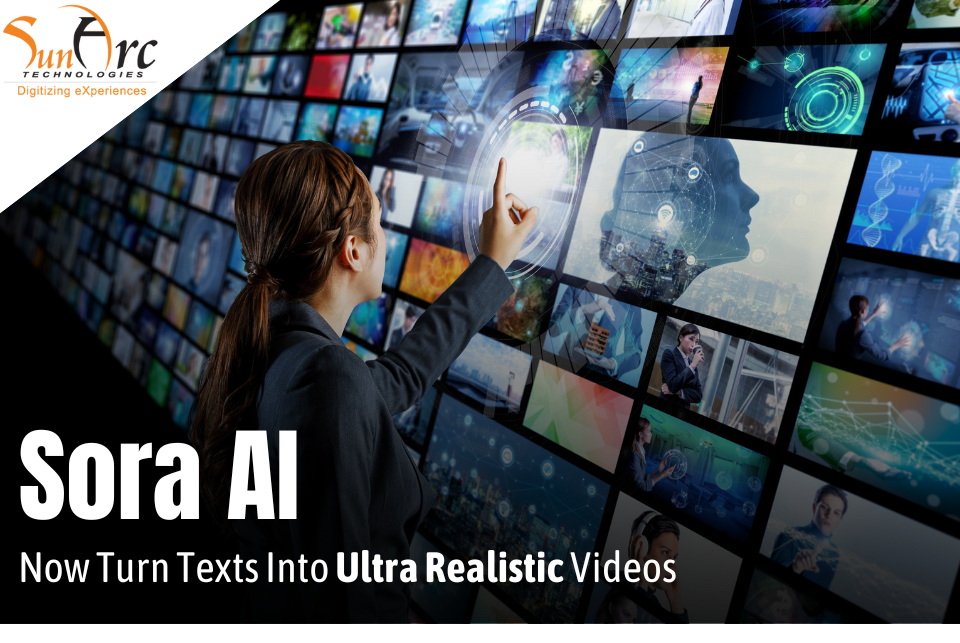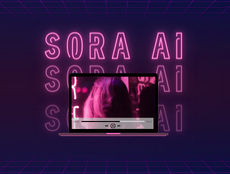Sora AI, the groundbreaking text-to-video generative artificial intelligence model, has recently been released by OpenAI.
Recent developments in computer vision and natural language processing (NLP) have paved the way for the generation of high-definition videos using just written instructions. This advanced system can mimic human storytelling abilities by reading user input, writing scripts, recognizing images, and using deep learning models.
What’s more?
Let’s check it out..!!

What Is Sora AI?
The creators of ChatGPT, OpenAI, have introduced Sora, an AI model specializing in transforming text into videos. This “text-to-video” capability means Sora can convert written instructions into concise video segments. The recent batch released by OpenAI showcases truly impressive results.
Sora, functioning as an artificial intelligence tool, can generate complete videos lasting up to one minute. Users can input prompts like “a bunch of dogs playing on the ice,” Sora will produce a video that matches the given description.
Interestingly, Sora’s rise to attention wasn’t accompanied by a big announcement or promotional campaign; it surfaced unexpectedly. OpenAI has shared sample videos illustrating Sora’s capabilities, depicting lifelike videos with details like a woman walking down a Tokyo street, A street-level tour through a futuristic city, etc.
How Does Sora AI Work?
Sora AI is built upon an innovative adaptive diffusion model, a distinctive approach where a video initially emerges from static noise and undergoes successive refinement by eliminating noise in stages. This methodology allows for the creation of entire films in a single attempt and facilitates the extension of existing ones.
A notable feature of Sora is its ability to simultaneously analyze multiple frames, ensuring the content remains cohesive even when momentarily concealed.
By utilizing a transformer system that draws inspiration from GPT, Sora accomplishes remarkable gains in terms of scalability. Instead of using tokens, which are used in GPT models, this method breaks down movies and pictures into smaller data units called patches. Sora AI stands out when turning text into videos because of its advanced mix of the adaptive diffusion model and transformer architecture. It results in incredibly coherent and clear videos.
Use Cases of Sora AI
1. Social Media
Sora AI would help marketers a lot. Generating videos for social media platforms will become much easier with the help of AI tools.
Marketers can easily create those videos for Instagram, TikTok, and YouTube shorts that they could only imagine but were not easy to create.
Read more: How AI Can Reshape Your Brand’s Online Reputation Management?
2. Product Advertising
Sora OpenAI will be a very effective asset regarding product advertising and marketing. Through the years, the production of advertising, promotional movies, and product demonstrations has traditionally been associated with high costs. On the other hand, when text-to-video artificial intelligence techniques like Sora are utilized, this procedure becomes far more cost-effective.
3. Prototyping and Concept Visualization
Artificial intelligence (AI) movies are useful for quickly showing concepts, regardless of whether they end up in the final product. With the help of Sora AI, filmmakers can develop scene mockups before filming, and designers can make product showcase movies before the real building of the product takes place. This gives a dynamic approach to picture concepts before committing to full-scale production, which speeds up the idea iteration process.
4. Synthetic Data production
Sora AI can help to generate synthetic data. When actual data cannot be used due to privacy or practicality concerns, synthetic data is often used instead. There must be tight control over access to the real datasets when dealing with numerical data, such as bank records or personally identifying information. Making synthetic data, though, is one way to overcome this obstacle.
Read more: How Gemini AI Makes Teamwork Magical?
Who Can Access Sora AI?
Sora AI is now only available to select content creators and red teamers (cybersecurity professionals). Access is currently restricted and selective.
Red teamers thoroughly examine Sora AI to find any possible weaknesses, hazards, vulnerabilities, or chances for abuse. This process greatly strengthens and secures the technology.
Concurrently, a carefully chosen group of content producers—designers, filmmakers, and visual artists—interact with Sora. Their exchanges highlight the AI’s capabilities and show how it may be used to improve a range of creative processes. This ongoing feedback loop is essential to OpenAI’s attempts to enhance and improve Sora, making it a more powerful and adaptable tool for a variety of creative activities.
What’s Next?
In the near future, we can expect to witness advanced uses of Sora AI. Like:
1. Creating High-Level Content
Sora has the potential to significantly speed up production processes in various industries, such as Virtual Reality (VR), Augmented Reality (AR), video games, and traditional entertainment such as TV and movies. While not directly responsible for producing the end product, it can be used for prototyping and storyboarding to enhance the brainstorming process.
2. Entertainment Tailored Just for You
Imagining a future where Sora creates and customizes content to suit each person’s tastes could lead to the development of extremely personalized and engaging media. By tailoring to each person’s distinct preferences, this approach has the potential to transform the entertainment industry.
3. Customized Learning
The personalized content produced by tools such as Sora could be useful in the field of education. By customizing the approach, students can receive personalized assistance that caters to their individual needs, resulting in a more effective and tailored educational experience.
4. Editing videos in real-time
Sora introduces a new feature that enables real-time video editing, making it possible to modify or recreate content on the spot for various viewers. Adjusting elements like tone, complexity, or narrative based on viewer preferences or feedback can provide a more engaging and personalized viewing experience.
Final Words
Sora from OpenAI is a unique text-to-video model, representing a significant advancement in generative video technology. The excitement building up for its upcoming launch indicates a major influence on the world of digital content creation in today’s digital age.
Ultimately, Sora AI is a significant advancement in AI-driven video generation, but its current limited availability has left creators eager for more access. Thankfully, the wait won’t be too long because Sora AI is about to be accessible to everyone, offering a wider and more inclusive reach soon.

